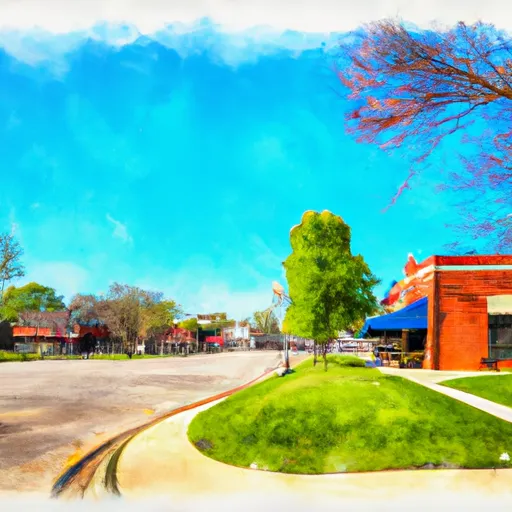-
 Snoflo Premium
Snoflo Premium
Get unlimited access to all our content
With no Ad interruptions! - Start Your Free Trial Login with existing account
Mendon
Eden Index
Climate
8.1
•
Recreation
2.2
•
Community
2.6
•
Safeguard
4.6/10

Mendon, Illinois is a small village located in Adams County with a population of approximately 900 residents. The village experiences a humid continental climate, characterized by hot and humid summers, cold winters with moderate snowfall, and moderate precipitation throughout the year.
Hydrology constituents in Mendon are primarily influenced by the nearby Mississippi River, which provides the area with a valuable water resource. Additionally, there are several small creeks and streams that contribute to the hydrological system in the region.
Mendon offers outdoor enthusiasts a variety of recreational opportunities. The village is surrounded by picturesque countryside, making it ideal for activities such as hiking, biking, and birdwatching. The nearby Siloam Springs State Park is a popular attraction, offering fishing, boating, camping, and picnicking opportunities. The park also features scenic trails that allow visitors to explore its diverse flora and fauna.
In conclusion, Mendon, Illinois offers a pleasant climate with distinct seasons, abundant water resources, and various outdoor recreation opportunities for residents and visitors alike.
What is the Eden Index?
The Snoflo Eden Index serves as a comprehensive rating system for regions, evaluating their desirability through a holistic assessment of climate health, outdoor recreation opportunities, and natural disaster risk, acknowledging the profound impact of these factors on livability and well-being.
Climate Health Indicator (CHI): 8.1
Mendon receives approximately
964mm of rain per year,
with humidity levels near 83%
and air temperatures averaging around
12°C.
Mendon has a plant hardyness factor of
5, meaning
plants and agriculture in this region thrive during a short period during spring and early summer. Most
plants will die off during the colder winter months.
By considering the ideal temperature range, reliable water supplies, clean air, and stable seasonal rain or snowpacks, the Climate Health Indicator (CHI) underscores the significance of a healthy climate as the foundation for quality living.
A healthy climate is paramount for ensuring a high quality of life and livability in a region, fostering both physical well-being and environmental harmony. This can be characterized by ideal temperatures, reliable access to water supplies, clean air, and consistent seasonal rain or snowpacks.
Weather Forecast
Streamflow Conditions
Upper Mississippi-Salt
Area Rivers
Upper Mississippi-Salt
Snowpack Depths
Upper Mississippi-Salt
Reservoir Storage Capacity
Upper Mississippi-Salt
Groundwater Levels
Recreational Opportunity Index (ROI): 2.2
The Recreational Opportunity Index (ROI) recognizes the value of outdoor recreational options, such as parks, hiking trails, camping sites, and fishing spots, while acknowledging that climate plays a pivotal role in ensuring the comfort and consistency of these experiences.
Access to outdoor recreational opportunities, encompassing activities such as parks, hiking, camping, and fishing, is crucial for overall well-being, and the climate plays a pivotal role in enabling and enhancing these experiences, ensuring that individuals can engage in nature-based activities comfortably and consistently.
Camping Areas
| Campground | Campsites | Reservations | Toilets | Showers | Elevation |
|---|---|---|---|---|---|
| Farr Park | 108 | 26 ft | |||
| Lake Chicot State Park | None | 128 ft | |||
| Great River Road State Park | None | 150 ft | |||
| Chicot County RV Park | 98 | 111 ft | |||
| Warfield Point Park | None | 132 ft | |||
| Lake Bruin State Park | None | 75 ft | |||
| Oak Grove City Park | 30 | 117 ft | |||
| Notrebes Bend | None | 160 ft | |||
| Natchez State Park | None | 236 ft | |||
| Grand Gulf Military Park | 42 | 238 ft |
Nearby Ski Areas
Catastrophe Safeguard Index (CSI):
The Catastrophe Safeguard Index (CSI) recognizes that natural disaster risk, encompassing floods, fires, hurricanes, and tornadoes, can drastically affect safety and the overall appeal of an area.
The level of natural disaster risk in a region significantly affects safety and the overall livability, with climate change amplifying these risks by potentially increasing the frequency and intensity of events like floods, fires, hurricanes, and tornadoes, thereby posing substantial challenges to community resilience and well-being.
Community Resilience Indicator (CRI): 2.6
The Community Resilience Indicator (CRI) recognizes that education, healthcare, and socioeconomics are crucial to the well-being of a region. The CRI acknowledges the profound impact of these elements on residents' overall quality of life. By evaluating educational resources, healthcare accessibility, and economic inclusivity, the index captures the essential aspects that contribute to a thriving community, fostering resident satisfaction, equity, and social cohesion.

